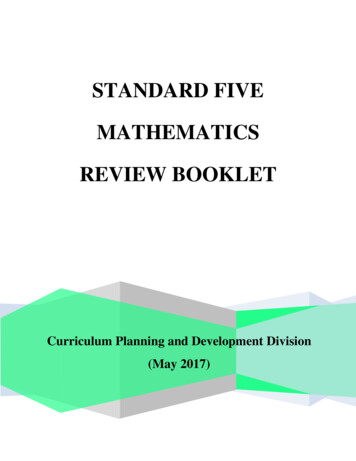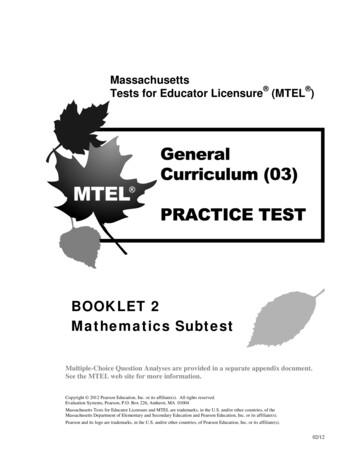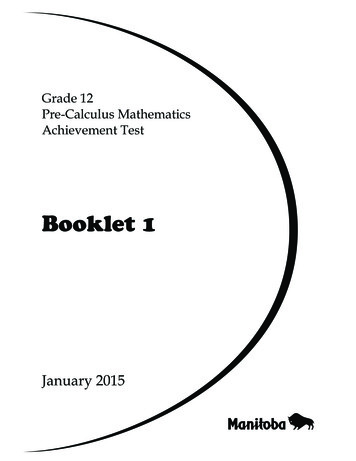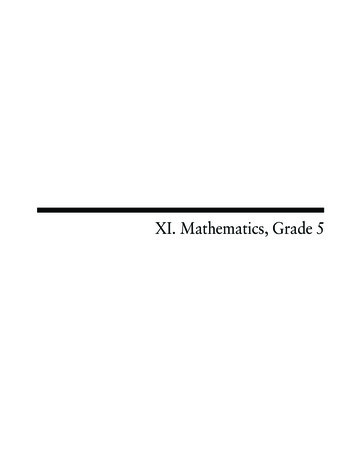
Transcription
STANDARD FIVEMATHEMATICSREVIEW BOOKLETCurriculum Planning and Development Division(May 2017)
NOTES TO STUDENTS The booklet highlights some important facts that students are required to know inMathematics through their preparation for the SEA, as prior knowledge for Form One.The booklet can be used as a resource for revision by students as they transition from UpperPrimary to Form One.This booklet is not to replace the teaching of concepts, procedures and problem solving ifreinforcement of these skills is needed by students.Examples/illustrations are provided.
Produced by:Patrick Ramdath, Curriculum Officer - MathematicsContributors:Hazra Baksh, Barrackpore A.S.J.A. PrimaryVernon Birbal, South Oropouche Government PrimaryNicole Harris-Knudsen, Curriculum Coordinator (Ag.) - MathematicsAndrea Khan, VOS Government PrimaryLyndon Lewis, Arima Boys’ R.C. PrimaryRichard Morealy, Carapichaima R.C. PrimaryNicholas Nanan, San Fernando Boys’ Government PrimaryJacqueline Pariag, Curriculum Officer - MathematicsChristine Rambaran, Longdenville Presbyterian PrimaryDonald Somai, Cedros Government PrimaryClarine Stewart, Vance River R.C. PrimaryEdited by:Nicole Harris-Knudsen, Curriculum Coordinator (Ag.) - MathematicsJacqueline Pariag, Curriculum Officer - Mathematics
ContentsA. NUMBER - Whole Numbers . 1A. NUMBER - Fractions . 16A. NUMBER - Decimals . 27A. NUMBER - Approximation and Computational Estimation . 35A. NUMBER - Percent . 39B. MEASUREMENT - Money . 43B. MEASUREMENT - Perimeter. 55B. MEASUREMENT - Area . 61B. MEASUREMENT - Volume . 63B. MEASUREMENT - Mass . 67B. MEASUREMENT - Time . 68C. GEOMETRY - Angles and Lines . 70C. GEOMETRY - Plane Shapes . 72C. GEOMETRY - Solids . 74C. GEOMETRY - Symmetry . 79C. GEOMETRY - Slides, Flips and Turns. 80D. STATISTICS . 81Mathematics Facts . 89
A. NUMBER - Whole NumbersFacts to RememberA factor is a number that divides another number,leaving no remainder.The number 1 is a factor of every number.Every number is a factor of itself.The largest factor of ANY number is the number itself.A multiple is the product of a number and anothernumber.Illustration/ ExampleFactors of 14 are 1, 2, 7, 14.14 1 1414 2 714 7 214 14 1The first four multiples of the number 8 are8, 16, 24, 32Every number is a multiple of itself.Even numbers are exactly divisible by 2.They are multiples of 2.Odd numbers ALWAYS leave a remainder of 1 whendivided by 2.A prime number is any number that has only twofactors: itself and 1.2 is the only EVEN prime number.2, 4, 6, 8, 10 2468101, 3, 5, 7, 9 22222 123451 2 0 Remainder 13 2 1 Remainder 15 2 2 Remainder 17 2 3 Remainder 19 2 4 Remainder 1Prime numbers are highlighted on the chart below.All other numbers beside the number 1 arecomposite.Numbers that are not prime numbers are calledcomposite numbers.1 is a unique number. It is neither prime norcomposite.CURRICULUM PLANNING & DEVELOPMENT DIVISION1
Facts to RememberA number can be represented in words and numerals.Illustration/ Example1.e.g.Hundreds2Tens1Units or Ones5Numeral:45 678Words:forty-five thousand, six hundred and seventy-eightExpanded Form:(4 10 000) (5 1 000) (6 100) (7 10) (8 1)2. Numeral:2153. Word name:Two hundred and fifteen4. Expanded form:(2 100) (1 10) (5 1)CURRICULUM PLANNING & DEVELOPMENT DIVISION2
Facts to RememberPlace value is the position of the digit in the numeral.It is represented by columns on the place value chart.Illustration/ ExampleExample:1 245The value is the worth of the digit.ThousandsHundredsTens124e.g. The numeral 789The place value of the digit 8 is tens.Units orOnes5The value of the digit 8 is eighty (80).place value of 5 is onesplace value of 4 is tensplace value of 2 is hundredsplace value of 1 is thousands::::value of 5 is 5value of 4 is 40value of 2 is 200value of 1 is 1000Ascending OrderExample:To arrange numbers in ascending order, place themfrom smallest (first) to largest (last).Place 17, 5, 9 and 8 in ascending order.Answer: 5, 8, 9, 17Example:Place 3, 1, 19, 12, 9, 2 and 7 in ascending order.Answer: 1, 2, 3, 7, 9, 12, 19Descending OrderExample:To arrange numbers in descending order, place themfrom largest (first) to smallest (last).Place 17, 5, 9 and 8 in descending order.Answer: 17, 9, 8, 5Example:Place 3, 1, 19, 12, 9, 2 and 7 in descending order.Answer: 19, 12, 9, 7, 3, 2, 1CURRICULUM PLANNING & DEVELOPMENT DIVISION3
Facts to RememberA basic Addition Fact is defined as thesum of two one-digit numbers.Illustration/ ExampleThe 100 Addition facts of single digit numbers:The sum of any number added to zerogives the same number.e.g.7 0 7Addition on the number lineWhen adding on a number line, move tothe right.4 5 98 7 15Example:3 4Begin at 3, then move 4 steps to the right.Answer: 7CURRICULUM PLANNING & DEVELOPMENT DIVISION4
Facts to RememberAddition with regroupingIllustration/ ExampleExample:Add 4529 733Place all digits in the correctcolumns. Add the digits in the onescolumn: 9 3 12.The number 12 represents 1 groupof ten and 2 ones.Place the digit 2 in the answerspace for the ones column and thedigit 1 above the tens column.Add the digits in the tenscolumn: 1 2 3 6.Place the digit 6 in the answerspace for the tens column.Add the digits in the hundredscolumn: 5 7 12.The number 12 represents 1200,one thousand and two hundreds.Place the digit 2 in the answerspace for the hundreds column.Place the 1 from the number 12above the thousands column.Add the digits in the thousandscolumn: 1 4 5.Place the digit 5 in the answerspace for the thousands column.TH H457Example:This law states that the result for additionwill be the same when the order of thenumbers changes.2 3 5 103 5 2 10O931TH4 H57T23O932211TH4 H571TH4 1TH4 T236O9321H572215Commutative Law of AdditionT23T236O9321H572T236O932same result5 3 2 10CURRICULUM PLANNING & DEVELOPMENT DIVISION5
Facts to RememberSubtraction on the number lineIllustration/ ExampleExample:When subtracting on a number line, move tothe left or move backward.6–4 2Begin at 6, then move 4 steps backward.Answer: 2CURRICULUM PLANNING & DEVELOPMENT DIVISION6
Facts to RememberSubtraction with regroupingIllustration/ ExampleExample:Subtract 4792 from 6538Place all digits in the correctcolumnsIn the ones column,subtract 2 from 8: 8 – 2 6.Place the digit 6 in the answerspace for the ones column.In the tens column, 3 is less than 9.To subtract, you need to take 1hundred and regroup to 10 tens.1 hundred is the same as 10 tens.10 tens added to 3 tens equal 13tens.13 tens subtract 9 tens equal 4 tens.Place the digit 4 in the answerspace for the tens column.In the hundreds column, 4 is lessthan 7.To subtract, you need to take 1thousand and regroup to 10hundreds.10 hundreds added to 4 hundredsequal 14 hundreds.14 hundreds subtract 7 hundredsequal 7 hundreds.Place the digit 7 in the answerspace for the hundreds column.In the thousands column,subtract 4 from 5: 5 – 4 1.Place the digit 1 in the answerspace for the thousands column.CURRICULUM PLANNING & DEVELOPMENT 47T394O826T394O826T394O826–TH6541H5 1477–TH6541H5 14771117
Facts to RememberThe product of 3 and 4 is 12.3 4 12Illustration/ ExampleExample:Three ways of calculating 246 31. Area Model:(3 200) (3 40) (3 6) 600 120 18 7383 2003 403 62. Regrouping6 3 18(1 ten and 8 ones).Regroup and add 1 to thetens column.4 tens 3 12 tens(1 hundred and 2 tens)Regroup and add 1 to thehundreds column.3. Repeated Addition2 4 62 4 6 2 4 67 3 8CURRICULUM PLANNING & DEVELOPMENT DIVISION8
Facts to RememberMultiplication using Partial ProductsIllustration/ ExampleExample:21 122 1 1 224 01 02 0 02 5 2The product of any number and 1 is thesame number.Ones by OnesTens by OnesOnes by TensTens by TensMultiplication Facts to 144e.g.7 1 1 7 7The product of any number and 0 is 0.e.g.7 0 0 7 0Pattern for multiplication by 10:1 10 102 10 203 10 304 10 405 10 50Commutative Law for MultiplicationExample:This law states that if two or morenumbers are multiplied the result will bethe same no matter their order.5 3 15same result3 5 15Example:4 2 6 486 4 2 482 4 6 48CURRICULUM PLANNING & DEVELOPMENT DIVISIONsame result9
Facts to RememberDivision can be represented by grouping orpartitioning.Illustration/ ExampleExample:Divide 4707 by 32We are dividing by 32. Here are some multiplicationfacts for 32:1 32 32032 ) 4-3117 0 72547 hundreds 32 100 setsof 32 with aremainder of15 hundreds.4 32 128032 ) 4-31-117252240 7082150 tens 32 40 sets of 32with aremainder of22 tens7 32 224032 )4-31-1172522-24 70 7082 72 43227 32 7sets of 32 witha remainder of34707 is the dividend32 is the divisor147 is the quotient3 is the remainderZero divided by any number equals zero.Example:05Any number divided by itself equals 1, except thenumber 0. 0Example:1 1 12 2 13 3 110 10 1CURRICULUM PLANNING & DEVELOPMENT DIVISION10
Facts to RememberIn multi-step word problems, one or moresteps must be solved in order to get theinformation needed to solve the finalquestion.Illustration/ ExampleExample:Jason played three games at the mall. He won 33 tickets fromBasketball Hoops and 18 tickets from Air Hockey. He wonthree times the number of tickets from Car Racing as he didfrom Air Hockey.How many tickets did Jason win altogether?Solution 1:No. of tickets won from Basketball Hoops 33No. of tickets won from Air Hockey 18Step 1:No. of tickets won from Car Racing 18 3 54Step 2:Total number of tickets won Tickets from Basketball Hoops and Air Hockey and Car Racing 33 18 54 105Solution 2:Step 1:No. of tickets won in Air Hockey & Car Racing 18 4 72Step 2:Total number of tickets won Air Hockey and Car Racing Tickets Basketball Hoops Tickets 72 33 105Answer: Jason won 105 tickets altogether.Example:Marcus had 600 marbles. He gave away 175 marbles and putthe remaining marbles equally into 5 bags.How many marbles were there in each bag?Solution:Step 1:600 – 175 425He had 425 marbles left.Step 2:425 5 85There were 85 marbles in each bag.Answer: Each bag had 85 marbles.CURRICULUM PLANNING & DEVELOPMENT DIVISION11
Facts to RememberThe square of a number is the product of thenumber and itself.Illustration/ ExampleExample:4 4 16, so 16 is a square numberSquare numbers can be represented by objectsarranged as a square as shown below:e.g.22 is read as “the square of 2”.32 is read as “the square of 3”.42 is read as “the square of 4”.Square Numbers1222324252627282921024916The sequence of square numbers is shown below:1, 4, 9, 16, 25, 36, The square number pattern is shown below:12 122 1 332 1 3 542 1 3 5 752 1 3 5 7 962 1 3 5 7 9 11The rule for the pattern or sequence isthe sum of the odd numbers.149162536 CURRICULUM PLANNING & DEVELOPMENT DIVISION 1 2 3 4 5 6 7 8 9 10 1 2 3 4 5 6 7 8 9 10 2302402502 01600250012
Facts to RememberThe square root of a number is that number whenmultiplied by itself would give the original number. Illustration/ ExampleA square root of 9 is 3, because the product of 3and itself is 9.is the symbol used for the square root.e.g. 4 is read as “the square root of 4”. 9 is read as “the square root of 9”.Square RootsExamples: 1 4 9 16 25 36 49 64 81 100 121 144 169 196 225CURRICULUM PLANNING & DEVELOPMENT DIVISION 123456789101112131415 12 22 32 42 52 62 72 82 92 102112122132142152 14916253649648110012114416919622513
Facts to RememberThe cube of a number is the product of the samenumber three times.ORThe cube of a number is a multiplication in whichthe same number is used three times.e.g.Illustration/ ExampleCube Numbers03132333435363738393103 0 1 2 3 4 5 6 7 8 9 10 0 1 2 3 4 5 6 7 8 9 10 0 1 2 3 4 5 6 7 8 9 10 031323334353637383931030 1 8 27 64 125 216 343 512 729 100044443 4 4 4 6443 is read as “the cube of 4”.CURRICULUM PLANNING & DEVELOPMENT DIVISION14
Facts to RememberA sequence or pattern is a set of numbers or objectsthat are in a particular order based on a rule.Illustration/ ExampleExample:e.g.Pattern rule: “subtract 3”3, 8, 13, 18, 23, 28, 33, 38, .This sequence has a difference of 5 between eachnumber.The sequence or pattern rule is “add 5”.27, 24, 21, 18,27,24211815 27 24 21 18––––3,3,3,3The missing number in the sequence is 15.Example:3, 4, 6, 9, 13, 18,Pattern rule: Add 1 to the first number, add 2 tothe second number, add 3 to the third number, etc.3,4691318 346913 1,2,3,4,5The missing number in the sequence is 24.Example:64, 32, 16, 8,Pattern rule: Divide by 264,321684 6432168 2,2,2,2The missing number in the sequence is 4.CURRICULUM PLANNING & DEVELOPMENT DIVISION15
A. NUMBER - FractionsFacts to RememberA fraction is a part of a whole.Illustration/ ExampleFor the purpose of naming fractions,wholes are divided into equal parts.1 numerator2 denominator how many parts names the partHere are some of the most commonfractions, and how to call them:1213141537is one-halfis one-thirdis one-quarteris one-fifth and so onis read as three-sevenths (or 3 out of 7)A unit fraction is a fraction where thenumerator is 1.E.g.12,13,14,15,16and so on.CURRICULUM PLANNING & DEVELOPMENT DIVISION16
Facts to RememberYou can create equivalent fractions bymultiplying or dividing both top and bottom by thesame number.Illustration/ ExampleThe rule to remember is:"Change the bottom using multiply or divide,and the same to the top must be applied"Here is why those fractions are really the same: 2 214 28 2 416 2Here are some more equivalent fractions, this time bydividing: 525100 5Ordering FractionsExample:When the numerator stays the same, and thedenominator increases, the value of the fractiondecreases, i.e. the fraction is smaller.1When the numerator stays the same, and thedenominator decreases, the value of the fractionincreases, i.e. the fraction is larger.237,1,346CURRICULUM PLANNING & DEVELOPMENT DIVISION,1,375,,11034 5520 14 5The fraction is getting smaller.The fraction is getting larger.17
Facts to RememberWe can compare two fractions to discover whichis larger or smaller.There are two main ways to compare fractions:1) Using the same denominator.Illustration/ ExampleExample:35Which is bigger: 8 or 12?Solution:Make the denominators the same using equivalentfractions 338 2924510 1224and 39 21024is smaller than 24, because 9 is smaller than 10.5Answer: 12 is the larger fraction.2) Using decimal fractionsExample:38There are three types of fractions: 0.375 and5125 0.4166 so 12 is bigger.Example:1) Proper Fraction (Common Fraction) - Afraction with a numerator smaller than itsdenominator. The value of the fraction isalways less than one or a whole.2) Improper Fraction- A fraction with itsnumerator larger than its denominator.Improper fractions always have a value greaterthan 1.3) Mixed Number - A value expressed usingboth a whole number and a proper fraction1e.g. 1211 is the whole number and 2 is the fraction.CURRICULUM PLANNING & DEVELOPMENT DIVISION18
Facts to RememberConversion of an Improper Fraction to a MixedNumberIllustration/ ExampleExample:ConvertTo convert an improper fraction to a mixednumber, follow these steps: Find the number of wholes Express the remainder as a fraction𝟏𝟏to a mixed number.𝟒Solution:114114 444 4 34 1 1 34 2 2 wholes with a remainder of3434ORDenominatorAnswer: 2Conversion of a Mixed number to an ImproperFractionTo convert a mixed number to an improperfraction, follow these steps: Express wholes as fractions Simplify the numerator State the result115 5 444 4 4 4 4 1 4 4 4 4 4 4 5 4 14 2142 Whole number 4 1 1– 83 Remainder is 3434Example:2Convert 3 5 to an improper fraction.Solution:322 3 55 5 5 5 5 2 555175Answer:CURRICULUM PLANNING & DEVELOPMENT DIVISION5 55 25(express wholes as fractions)(3 5) 25(simplify the numerator)17519
Facts to RememberAddition of fractions with the samedenominatorIllustration/ ExampleExample:Adding seventhsAdd the numerator and keep the samedenominator.Subtraction of fractions with the samedenominatorThree sevenths add two sevenths five seventhsExample:Subtracting quartersSubtract the numerator and keep thedenominator.All whole numbers can be expressed as afraction with a denominator of 1.Three quarters subtract two quarters one quarterExample:Find𝟓𝟔 24.Solution:5 2465 24 6 1 5 244 6115 41 120 1 20Answer: 20CURRICULUM PLANNING & DEVELOPMENT DIVISION20
Facts to RememberExpressing one number as a fraction ofanother numberIllustration/ ExampleExample:What fraction of 60 is 45?Solution:45 write 45 as the numerator of the fraction60 write 60 as the denominator of the fractionReduce the fraction to its lowest term.4560 45 1560 153 4OR4560912Finding the whole given a fractional partDraw diagrams to show information givenabout the fraction of a number. 45 5 9 360 512 39 1234Example:𝟐𝟓of a number is 20. What is the number?101010101020𝟐5of a number is 20.Therefore𝟏5of the number is 10.The whole or𝟓5of the number is 50.Answer: The number is 50.CURRICULUM PLANNING & DEVELOPMENT DIVISION21
Facts to RememberYou can find the whole number given afraction of the number using bar modeling.e.g.35Illustration/ ExampleExample:Three-eighths of the town voted in an election. If 120 ofthe people voted, how many people lived in the town?Solution:of a group of children were girls. If therewere 24 girls, how many children were therein the group?Step 1. Draw the whole divided into eighths:3Step 2. Represent :83For , bracket 3 parts, then bracket the remaining parts.833 units 241 unit 24 3 85 units 5 8 40There were 40 children in the group.85voted 1208did not vote1Step 3. Divide 120 by 3 to find 8 of the people who voted.1120 3 40, which is 8 of the people who voted4040404040404040Step 4. Add all the parts to find the whole group:40 40 40 40 40 40 40 40 320Answer: 320 people lived in the town.Other examples of worded problems are:1. Kareem said that four fifths of his age is 16 years.How old is Kareem?2. Charlie bought a book for 25.5He paid 6 of the regular price.What was the regular price of the book?CURRICULUM PLANNING & DEVELOPMENT DIVISION22
Facts to RememberMultiplication of FractionsIllustration/ Example1Example:3 916Three steps to multiply fractions:Step 1. Multiply the numerators:Step 1. Multiply the numerators1Step 2. Multiply the denominatorsStep 3. Simplify the fraction if needed.39 1 9 169 Step 2. Multiply the denominators:139 1 9 163 16 948Step 3. Simplify the fraction:9 33 OR48 3Reduce the fractions and then multiplynumerators and denominators.Example:5162 3 6563(Divide numerator and denominator by 3) 213 5 13 35 9Example:5519 10 6Make the whole number a fraction, by putting itover 1.Think of the whole number as being thenumerator and 1 as the denominator:Example:62 93102 1 32 2 34Example:23 9Solution:Step 1: Put the whole over 1.312 9Step 2: Multiply numerators and denominators.3 21 9 Answer:CURRICULUM PLANNING & DEVELOPMENT DIVISION6 9232323
Facts to RememberMultiplication of Mixed NumbersIllustration/ ExampleExample:To multiply mixed numbers, follow these steps:Multiply 12 2511Step 1. Convert to improper fractionsStep 1. Convert both to improper fractionsStep 2. Multiply the fractions12 25 2 1Step 3. Convert the result to mixed numbers13115Step 2. Multiply the fractions (multiply thenumerators and denominators):3 2115 3 112 533 10Step 3. Convert to a mixed number333 310103Answer: 310Division of FractionsExample:121412141 445Solution:Step 1. Turn the divisor upside down:44𝟒𝟒5𝟏𝟐 2133141𝟐2314 2 ( two in one-half)𝟏162121316161162163126𝟑 𝟔𝟏 𝟏𝟐𝟑4 435452 543 4 1012Step 3. Simplify the fraction:10Look at the pattern before we state the rule:Step 1. Turn the divisor (2nd fraction) upside (multiply the numerators and the denominators) 4 (four 6 in two-thirds)𝟐5Step 2. Multiply the 1st fraction by the 2nd one:1316becomesAnswer:down, i.e. invert.512 566Step 2. Multiply the 1st fraction by the 2nd one.Step 3. Simplify the answer, if needed.CURRICULUM PLANNING & DEVELOPMENT DIVISION24
Facts to RememberWord problems involving fractionsIllustration/ ExampleExample:Martha spent49of her allowance on food and shopping.What fraction of her allowance did she have left?Solution:1–49 99–49 595Answer: She had of her allowance left.9Example:2Sam had 120 teddy bears in his toy store. He sold of3them at 12 each.How much money did he receive?Solution:Step 1. Calculate the number of teddy bears sold.23 1201 231 120401 801He sold 80 teddy bears.Step 2. Calculate how much money he received.80 12 960He received 960.Answer: Sam received 960CURRICULUM PLANNING & DEVELOPMENT DIVISION25
Facts to RememberA factor tree breaks down a number into primenumbers.Illustration/ ExampleExample:Make a factor tree for the number 60Prime factorisation is expressing a number as aproduct of its prime factors.Note that the product of the prime factorization isthe original number.Step 1. Begin by writing down the number 60.Step 2. Below it write down any factor pair whoseproduct is 60. For example, write down 6 and 10on the branches because 6 10 60.Step 3.Step 4. Next repeat the process with the new branches.Since 2 3 6 and 5 2 10. Write thefactors underneath their respective branches.Circle the prime numbers.Prime Factorization:2 2 3 5 60CURRICULUM PLANNING & DEVELOPMENT DIVISION26
A. NUMBER - DecimalsFacts to RememberA decimal number is one which has wholenumber values and numbers with a fractionalvalue (less than 1).The whole number is separated from thefractional number by a decimal point.Illustration/ ExampleAs you move to the right in the place value chart, eachnumber place is divided by 10.Example:1000 10 100100 10 10The first digit after the decimal point is inthe tenths place value.10 10 1This is also true for digits to the right of the decimal point.The second digit after the decimal point is inthe hundredths place value.Example:The third digit after the decimal point is inthe thousandths place value.1 10 110110 10 or 0.1 (one tenth)1100or 0.01 (one hundredth)Example:OnesDecimal PointTens 1 71101(Tenths)100(Hundredths)5 910 times greater10 times smallerIn the number shown above:There are 5 tenths, having a value of 0.5 or510There are 9 hundredths, having a value of 0.09 orIn consumer arithmetic, the decimal point isalso used to separate dollars from cents inmoney.9100Examples: 1.50 represents one dollar and fifty cents 5.25 represents five dollars and twenty-five cents 175.00 represents one hundred and seventy-five dollarsCURRICULUM PLANNING & DEVELOPMENT DIVISION27
A. NUMBER - DecimalsDecimal Fractions in Expanded NotationExample:Express 17.59 using expanded notation.1117.59 (1 10) (7 1) (5 10) (9 100) 10 1070.50.0917.597 0.5 0.09T O .1 0 .7 . .1 7 .ORth00505hth00099Answer: 17.59 10 7 0.5 0.09Comparison of decimalsExample:We can use the methods below to comparedecimals:Put the following decimals in ascending order:Step 3. Fill in the empty squares withzeros.110Step 4. Compare the numbers using thefirst column on the left.Step 5. If the digits are equal move to thenext column to the right untilone digit is larger. HundredthsOnesStep 2. Put in each number.TenthsSolution:Decimal PointStep 1. Set up a table with the decimalpoint in the same place for eachnumber.1.5, 1.56, 0.8558060Order2nd3rd1stAnswer:The ascending order of decimals is 0.8, 1.5, 1.56.ORStep 1. Line up the decimal point.Step 2. Use zeros as place holdersStep 3. Visualize the numbers as wholeNote:To place numbers in ascending order start with thesmallest number first.numbers.Step 4. Compare the numbers fromsmallest to largest.To place numbers in descending order start with thelargest number first.CURRICULUM PLANNING & DEVELOPMENT DIVISION28
Facts to RememberAddition of decimal fractionsIllustration/ ExampleExample:To add decimals follow these steps:Add 1.45 to 1.3Step 1. Write the numbers, one under theother, with the decimal values oneunder the other.Step 1.Line up the decimals O11 O11O112 O10 O10O101 hth037Step 2. Use zeros as place holders.Step 3. Then add, remembering to put thedecimal point in the answer.Step 2.Use zeros as place holdersStep 3.Add .Answer: 2.75Subtraction of decimal fractionsExample:To subtract decimals, follow these steps:Subtract 0.03 from 1.1Step 1. Write down the numbers, one underthe other, with the decimal points oneunder the other.Step 2. Use zeros as place holders.Step 3. Then subtract, remembering to putthe decimal point in the answer.Step1.Line up the decimalsStep 2.Use zeros as place holdersStep 3.Subtract .Answer: 1.07CURRICULUM PLANNING & DEVELOPMENT DIVISION293
Facts to RememberMultiplication of decimal fractionsIllustration/ ExampleExample:If we look at the answers we see a pattern. We canuse the pattern to get a rule for multiplication bydecimal fractions.Tenths multiplied by Whole Numbers0.4 3Convert decimal fraction to regular fractions41012100.4 3 1.23 11210 1.20.4 3 1.2Example:Hundredths multiplied by Whole Numbers0.23 5Convert decimal fraction to regular fractions231001151000.23 5 1.15 5 1 111510015100 1.150.23 5 1.15Example:Tenths multiplied by Hundredths0.2 0.41Convert decimal fraction to regular fractions210 8210000.2 0.41 0.08241100 821000 0.0820.2 0.41 0.082Rule: the number of decimal places in theanswer is the total number of decimal placesfrom the numbers that are being multiplied.CURRICULUM PLANNING & DEVELOPMENT DIVISION30
Facts to RememberIllustration/ ExampleExample:Calculate the product of 3.7 2.8Solution:13249. 3 720. 7. 80661 decimal place1 decimal place2 decimal placesAnswer: 10.36Multiplication of decimal fractions by powers of 10Example: 10 – shift the decimal point 1 place to the rightMultiplication by 1010150.5 10 10 250.25 10 100 100 – shift the decimal point 3 places to the right5 1 511 101011Multiplication by 100310.31 100 100 100111150.15 100 100 100111 1000 – shift the decimal point 3 places to the right 311151 31 15Multiplication by 1000140.014 1000 1000 1𝟕𝟓0.75 1000 100 1CURRICULUM PLANNING & DEVELOPMENT DIVISION25 10 2.5100011 14110001 75011 14 75031
Facts to RememberIllustration/ ExampleDivision of a decimal number by a whole number Example:Step 1. Put the decimal point in the same spotas the dividend (the number beingdivided).Step 2. Continue division just as you wouldwith whole numbers.Divide 9.1 by 7.Put the decimal point in the quotient directly abovethe decimal point in the dividend.17 9 72 2.31110Answer: 1.3Division of a decimal number by another decimal Example:number8.64 1.2Step 1. Express as a fraction using the dividend Solution:as the numerator and divisor as thedenominatorStep 1. Express as a fraction:Step 2. Multiply by 10, or 100, or 1000, etc.until the divisor becomes a wholenumber.8.64 1.2 8.641.2Step 2. Multiply numerator and denominator by 10:Step 3. Continue division just as you wouldwith whole numbers.e.g.8.64 101.2 10 86.412Step 3.71 2 8 6 8 42 2. 2. 4. 4. 40Answer: 7.2CURRICULUM PLANNING & DEVELOPMENT DIVISION32
Facts to RememberDivision of decimal fractions by powers of 10Illustration/ ExampleExamples:When dividing a decimal by: 10 – shift the decimal point 1 place to the left3.24 10 0.324 100 – shift the decimal point 2 places to the left2.1 100 0.021 1000 –
Mathematics through their preparation for the SEA, as prior knowledge for Form One. The booklet can be used as a resource for revision by students as they transition from Upper Primary to Form One. This booklet is not to replace the teaching of concepts, procedures and problem solvin










